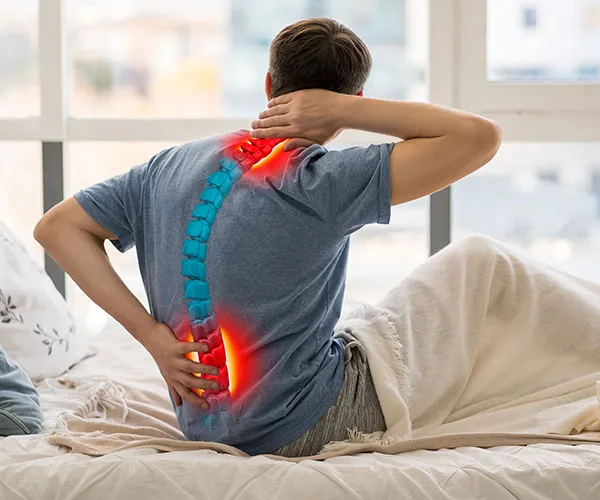

Now offering Primary Care services under Apex Primary Wellness! Schedule your visit today.
The degenerative disc disease occurs when the spinal discs wear down. These rubbery discs between the vertebrae act as shock absorbers by cushioning between the spinal column bones and allowing flexibility and mobility to your neck and back.
This condition is mainly seen among older adults. The spinal discs undergo wear and tear as part of the normal aging process. This increases bone friction, causing pain and other related health issues.
Depending on the area of your spine where the disc degeneration occurs, the disease can be classified into:
It occurs in the cervical spine or neck region (seven upper vertebrae), making head and neck movements painful.
It occurs in the lumbar spine (L1 to L5) and causes pain in the lower back.
With the right degenerative disc disease treatment, you can continue living a healthy, pain-free life in Coppell, Carrollton, Grapevine, TX, and surrounding areas.

You may have degenerative disc disease if you experience sharp neck and back pain along with the following symptoms:
Aging is believed to be the leading cause of degenerative disc disease. Most people over 40 have disc degeneration in varying degrees due to normal wear and tear of the discs. However, there are specific factors that cause degenerative disc disease, including:
At the time of birth, the discs have a soft inner core with about 80% water content. With advancing age, they become flatter and lose much water, leading to a reduced cushioning effect between the vertebrae.
The outer walls of the discs that contain nerves may develop cracks due to daily activities and injuries. If the wall breaks down, the disc may bulge outwards, resulting in a herniated disc.
Older adults are at a higher risk than others to have degenerative disc disease as aging is its leading cause. However, certain factors may increase your risk of developing the disease. The risk factors of degenerative disc disease are:
Excess body weight puts added strain on the spine, including the spinal discs, resulting in faster disc breakdown.
Performing a physically demanding job regularly can take a toll on the spinal discs over time.
A severe spinal injury can lead to the onset of degenerative disc disease that may deteriorate with time.
You may be at a higher risk if someone in your family has degenerative disc disease.
Besides increasing the likelihood of your having degenerative disc disease, smoking further worsens the condition.

For an accurate diagnosis of your condition, your pain specialist will:
Inquire about your symptoms
Perform a physical examination to check:
Run diagnostic tests, including:
Based on your symptoms and the severity of your condition, your doctor may offer the following DDD treatment options:
Pain relievers, including nonsteroidal anti-inflammatory drugs, muscle relaxers, and steroids, help control inflammation and reduce pain and swelling.
Certain degenerative disc disease therapies help strengthen your spine, leading to increased mobility and flexibility in your back.
These injections contain strong medication and are injected near the spinal nerves, discs, and joints to ease pain and inflammation
Radio waves destroy spinal nerve tissues and prevent them from sending pain signals to the brain.
Apex Interventional Pain & Spine is a leading pain management center serving Coppell, Carrollton, Grapevine, TX, and surrounding areas. Our team, led by Dr. Mohammed I. Khan, a board-certified physician specializing in physical medicine rehabilitation and pain management, is committed to providing the best pain solutions for a broad spectrum of acute and chronic conditions.
Our personalized degenerative disc disease treatments, including treatment for degenerative disc disease in the lower back, allow you to live a better-quality, pain-free life.
A few highlights of our exceptional services are:
Are you looking for the best doctor for degenerative disc disease in and around Coppell, Carrollton, and Grapevine, TX? Your search ends with us. Contact us today to schedule an appointment.